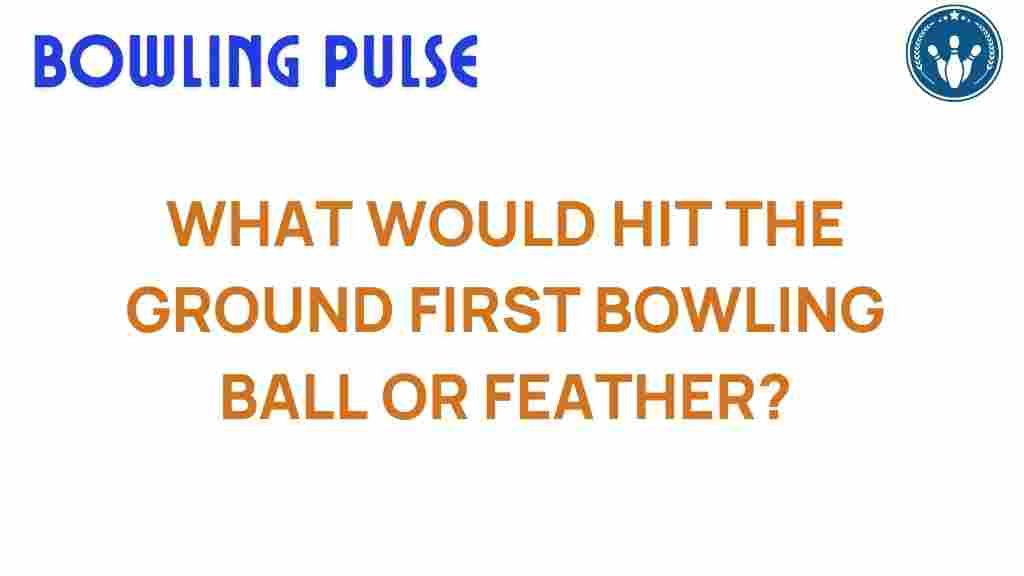The Gravity Challenge: Which Falls Faster, a Bowling Ball or a Feather?
In the realm of physics, few concepts are as intriguing as gravity. It governs the motion of objects and is a fundamental force in our universe. One of the most common experiments to demonstrate the effects of gravity involves dropping two very different objects: a bowling ball and a feather. This thought-provoking challenge not only captures the imagination but also leads to questions about the nature of free fall and the principles of science.
In this article, we will dive into the fascinating world of gravity, explore the outcomes of dropping a bowling ball versus a feather, and discuss experiments that anyone can conduct to understand these principles better. Prepare to unleash your inner scientist and satisfy your curiosity!
Understanding Gravity
Gravity is a force that attracts two bodies toward each other. The greater the mass of the objects, the stronger the gravitational pull. On Earth, gravity gives weight to physical objects and causes them to fall towards the center of the planet when dropped. But how does this force affect different objects? Let’s investigate!
The Physics of Falling Objects
When we drop an object, it accelerates towards the ground due to gravity. This acceleration is approximately 9.81 m/s² on Earth. However, the rate at which objects fall can be influenced by several factors, including air resistance, which plays a significant role when comparing a bowling ball and a feather.
- Bowling Ball: A heavy, solid object with minimal air resistance.
- Feather: A lightweight object with a large surface area relative to its weight, experiencing significant air resistance.
Setting Up the Experiments
To observe the effects of gravity on a bowling ball and a feather, you can conduct simple experiments at home or in a classroom setting.
Materials Needed
- A bowling ball
- A feather
- A tall building or a safe place to drop the objects from a height
- A stopwatch (optional)
- A camera (optional, for recording the experiment)
Step-by-Step Procedure
Follow these steps to conduct your own gravity experiment:
- Choose a Location: Find a safe, open area where you can drop the objects from a height. Make sure there are no obstacles below.
- Prepare the Objects: Hold the bowling ball in one hand and the feather in the other.
- Simultaneous Drop: Release both objects at the same time from the same height.
- Observe: Watch where each object lands. Note the time it takes for each to reach the ground.
- Repeat: Conduct the experiment multiple times to ensure accuracy.
Expected Results
In an ideal vacuum, where air resistance is absent, both the bowling ball and the feather would fall at the same rate and hit the ground simultaneously. However, in a real-world scenario, you will likely observe that the bowling ball reaches the ground much faster than the feather due to the significant air resistance acting on the feather.
Troubleshooting Tips
If you encounter issues while conducting your experiment, consider the following troubleshooting tips:
- Ensure a Clear Drop Zone: Make sure there are no obstructions that could interfere with the fall of either object.
- Use a Consistent Height: Drop both objects from the same height to ensure equal conditions.
- Minimize Wind Effects: Conduct the experiment indoors if possible to avoid wind interference.
- Record Your Observations: Use a camera or a stopwatch to document the fall times for more precise results.
Exploring the Science Behind the Results
The results of this experiment can lead to deeper discussions and explorations in science. Why do the bowling ball and the feather behave differently? This difference is primarily due to the concept of air resistance or drag, which opposes the motion of the objects falling through the air.
When the feather is dropped, the large surface area relative to its weight creates significant drag, causing it to flutter slowly to the ground. In contrast, the bowling ball has much less surface area compared to its mass, resulting in minimal drag and allowing it to fall rapidly.
The Role of Curiosity in Education
Curiosity is the driving force behind scientific discovery and education. Engaging in simple experiments like dropping a bowling ball and a feather not only enhances our understanding of gravity and physics but also inspires further exploration.
Encouraging students and young learners to ask questions and conduct experiments can lead to a lifelong passion for science. As educators, fostering an environment where curiosity is valued is essential for nurturing the next generation of thinkers and innovators.
Conclusion: The Fascinating Nature of Gravity
The experiment of dropping a bowling ball and a feather is a classic demonstration of the principles of gravity and free fall. While the expected outcome reveals that the bowling ball falls faster due to less air resistance, the real takeaway is the importance of curiosity and experimentation in science. Through simple experiments, we can explore profound concepts and deepen our understanding of the world around us.
For those eager to learn more about the principles of gravity and related physics concepts, check out this comprehensive guide to physics. And don’t forget to share your experiments and findings with others to inspire their scientific curiosity!
In the end, whether you are a student, educator, or simply a curious individual, the challenge of gravity continues to captivate and enlighten. So grab your bowling ball, your feather, and start exploring the wonders of physics today!
This article is in the category Techniques and created by BowlingPulse Team
